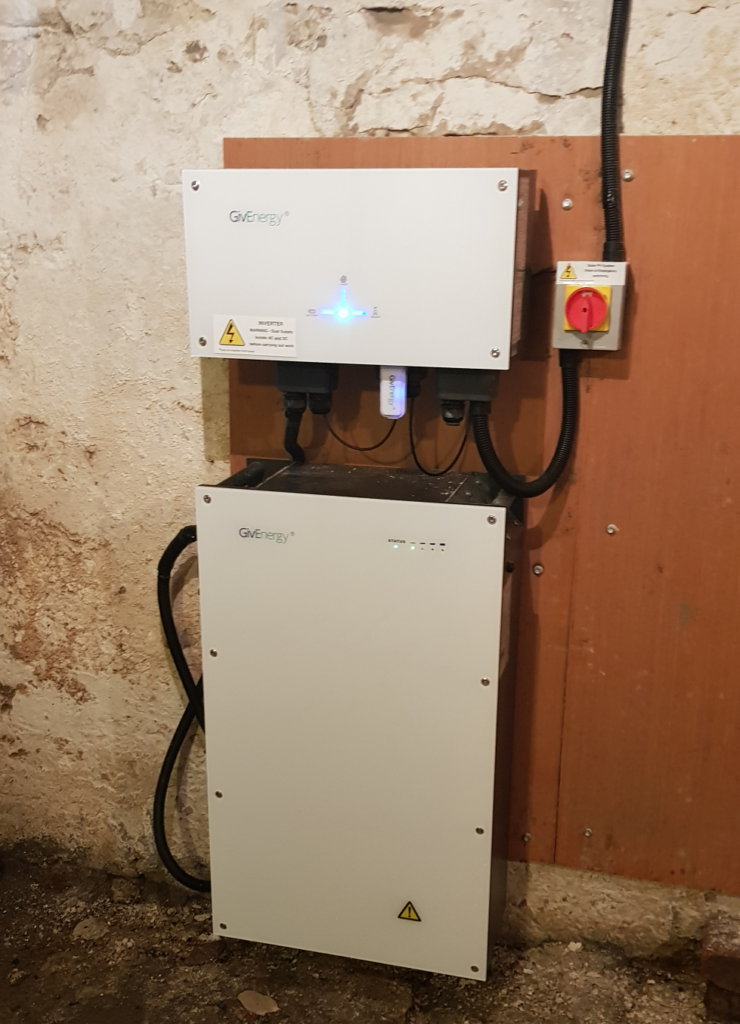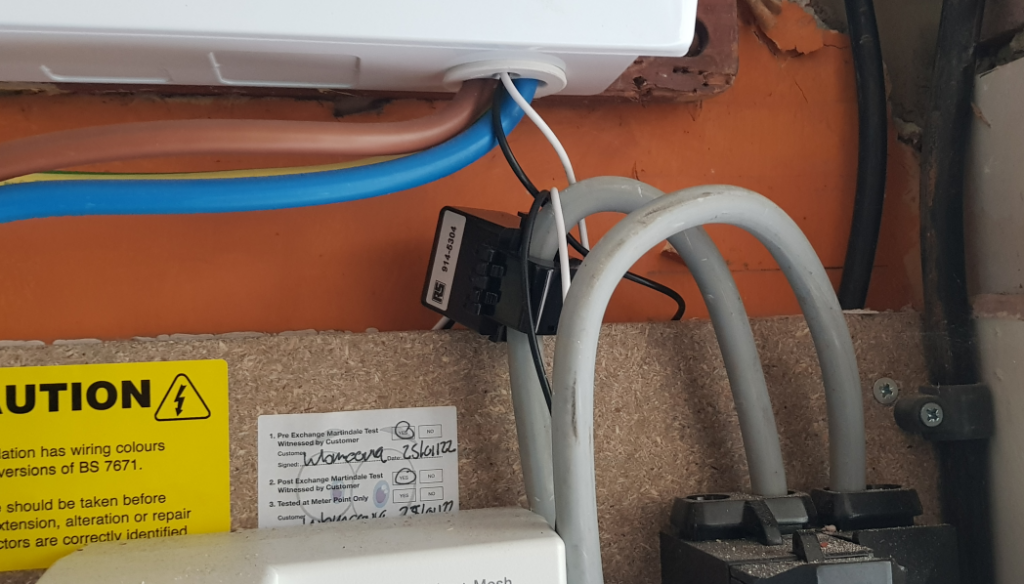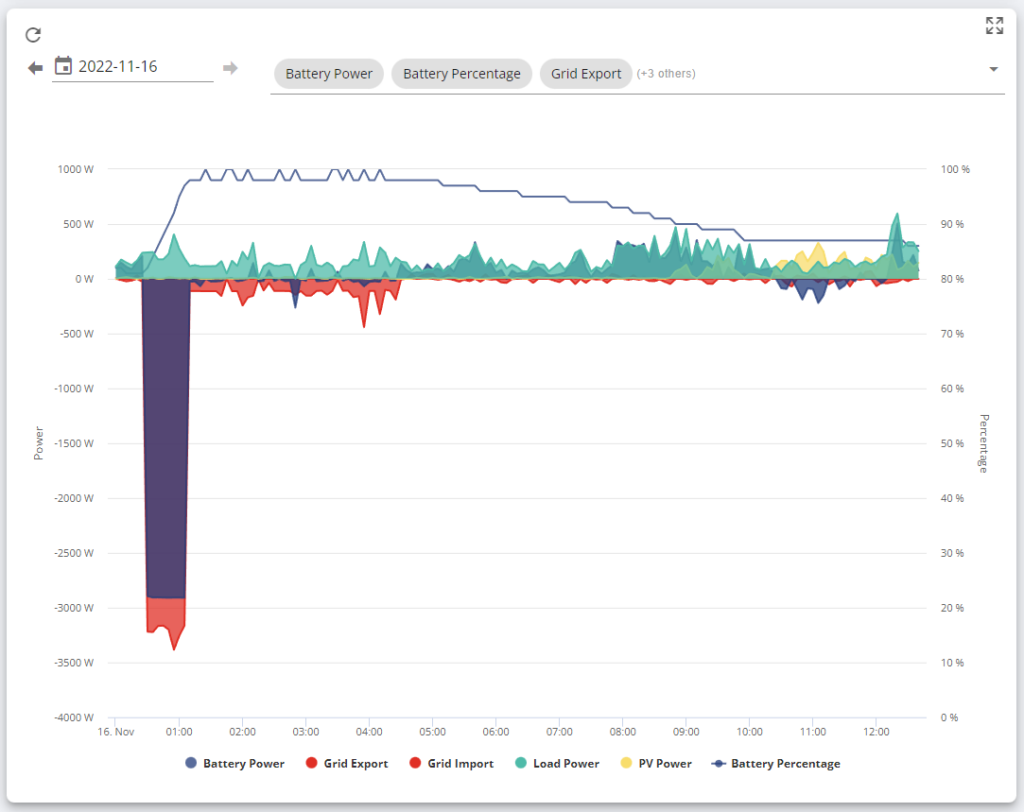At long last, its finally installed and actually working, and after a very long and very tedious process that I will not bore you with (much) my house now has a 9.5kwh home battery connected up and working in the cellar. Its actually powering everything in my house right now, and is super cool.
This has been a long process because just when I started to ask a company to install one, UK electricity prices went absolutely insane, and everyone and their dog suddenly wanted a home battery installation. Getting a Tesla powerwall would have meant possibly an even longer wait, and to be honest, they were quite pricey compared with what I eventually chose (a Givenergy 9.5kwh one), but even when I found an installer, and agreed to have a battery installed, there were endless delays. Initially I was going to have a 9.5kwh (latest model) battery, then it became obvious they were hugely delayed, so opted for a single 8.4kwh one, then at the very last minute it turned out a 9.5kwh one was available, and as this was the latest tech, that allowed 100% depth of discharge and unlimited cycles (basically you can fully fill/empty the battery whenever you like without affecting the warranty), so we went with that.
Getting people to come around and install the battery was one thing. Getting it actually finished was another. The installation has been a real pain, but TBH that seems to be mostly down to huge demand and chaos among all the companies doing this sort of thing right now. We had the battery installed, but dormant for about 4 weeks until a vital missing component showed up (a wifi dongle that allowed it to talk to my home network, and thus back home to the battery management system run by the battery company).
Now its all installed, it all feels like it sort of went ok though, because my ideal scenario was to put it in our cellar, which is damp, and dark and empty, and thus the perfect location. Why take up room in the house with a great big metal box when you are almost never going to have to physically go see it? I had worried that the installers would be negative about anything ‘non-standard’, but were happy to run the power cable from our kitchen fuse box outside the house, along a wall, then down through a hole into the cellar and the battery. I’m very happy with where it is:

When it was installed I asked them to set up a double size wooden board on the wall and allow space for a second similar size battery if I wanted to add another one at some stage. In practice, I doubt this will happen. The picture shows the battery (at the bottom) and above it is the inverter. Basically an inverter converts DC to AC or vice versa. This battery is ‘AC-coupled’ which means its on the ‘house’ side of the setup, and is wired in to the fusebox pretty much like anything else. It needs the inverter to convert that AC power so it can be stored in, or sucked out of the battery itself. On the plus side, if I got a 2nd battery, I don’t need another inverter, as you can just daisy-chain em. The red switch is an emergency cut-off.
Back upstairs in fusebox land, you end up with an extra widget called an EM115 that takes up one fuse slot. Its a fancy management thing that seems to be required to check everything works:

Connected to this widget is something called a CT clamp. This is a thing that wraps around a cable and tries to detect the power load going through it, and the direction of it. I already have one, used by my car charger in the garage, to ensure the charger never overloads the house grid connection. This new one is connected to the EM115 and the battery so the battery can tell whats happening with my grid connection:

This information is important because the battery uses it to do cool stuff. For example, you can say to the battery ‘Try to never export power to the grid!’, and then on a day where the solar power is high, and your consumption low, the CT clamp tells the battery that we seem to have a negative power flow (exporting to the grid) of X watts, and it therefore tells the battery to soak up X watts of power to balance it out and ensure any ‘surplus’ solar is kept in my house and not given for free to the evil energy supplier!
Whether or not this is what you want your battery to do is dependent on your circumstances. We got our solar panels 12 years ago on an early ‘feed-in-tariff‘. This means that we get credited a nice amount of money for each kwh of power our solar generates, regardless what happens to it, and we get a ‘deemed export’ of 50% of that. This means if our panels generate 10kwh, we get paid 10xFIT plus an extra 5xExportTariff. The actual export tariff is super low, so it wouldn’t be a good deal anyway, but as our tariff doesn’t measure the actual real export, we are kinda gaming the system a bit there by trying not to do any :D
For people with newer solar panels, they may actually have an export meter, and genuinely be paid per kwh they export. So why would you not do this? Because the very very best rates you get to export are insulting. I’ve seen a high of £0.07/kwh which is an insult considering that companies SELL you the same power for £0.24/kwh… Thus even if you do have an export meter, it makes more sense to keep that power in your home and use it later rather than sell it, then buy it back at a huge loss…
For people with normal jobs this is even more acute. In the UK summer your home solar will generate tons of power while you are out at work, which it sells for £0.07 for you to buy back in the evening to run your home at a huge loss. Sod that!
But enough about the economics! lets look at the real reason anybody gets a home battery – fun charts to look at:

This is one of the many views you get from the givenergy website. It also has app for your phone, obviously. This is my first day with the battery, and I screwed a lot of stuff up which I will explain. As part of its first-run ‘calibration’, the battery gets filled to 100% from the grid. Thus it was at about 80% full around midnight. I had then stupidly told it to fill to 100% between 00.30 and 4.00AM which is when my electricity is 75% off. It did this (see the top purple line going up to 100%) by importing that power from the grid. Thats the red section below the base line on the left, and the purple is it filling the battery
The red is a bit higher than the purple (well…below…) because I also needed *some* power to run the house even overnight.
I had screwed up twice because I’d told the battery to only discharge from 4.00am onwards, so between about 1.30-4am you can see those red downward spikes showing me importing power to deal with our energy demand (green upwards). Then from about 4am onwards, that disappears and we are running entirely from the battery since then (including now). Thus the battery level is slowly running down (top purple line).
The UX of the app is not amazing, hence my screwups, but I think I’m getting the hang of it now. You can see on the RHS of the chart some downwards purple and some upwards yellow. Yellow is the output of our solar panels, and for a period there it exceeded our energy usage, so the excess was dumped back into the battery. Working as intended!
You also get real time data like this:

This sort of thing can drive someone insane, because very often the numbers do not match up exactly, and you start to wonder if everything is broken. It isn’t, but you have to get your head around two concepts:
Firstly, the accuracy is not perfect. We do not have an export meter, so we are relying on some pretty rough measurements of power flows being detected by a loosely attached metal clamp on a cable. Thus you have to allow for a bit of a fuzz factor.
Secondly, the battery response is not instant, but has a slight lag. This is REALLY important, and can cause confusion. For example, say you are consuming 200w of power, and the battery is happily supplying 200w from power you saved up earlier. All is good. Then suddenly you switch a 2,000w kettle on. That power HAS to come immediately, and the battery is not set to do it, so for a few seconds, the extra 2,000w comes from the grid. The clamp detects this, tells the battery, and the battery ramps up to output 2,200w instead. Kettle finishes boiling, but the battery is still at 2,200w. The excess automatically flows to the grid. The clamp then detects that, the battery is told, and ramps down to 200w again.
That all sounds ok, but what it means is we briefly imported 2,000w from the grid, and then later briefly exported 2,000w as well. In the grand scheme of energy flows, its a minor deviation, but that is why there is not a perfectly flat line between 4am and now, with zero grid import or export. The import/export is VERY low compared to normal, but it still does happen.
If you have a smart meter in-home-display you will already be fairly familiar with this. In theory your TV will use maybe 200w for example, but you only need a helicopter to explode in an action movie, with a big loudspeaker-driving bang, followed by a loudspeaker-minimal silence, to see that the per-second power draw of almost everything is very, very variable.
I guess this is early home battery technology. Maybe eventually this sort of thing will be somehow perfect with sub-second response times. Maybe thats really hard on some components and electrically tricky. I don’t know, I’m just some guy with a battery in his cellar.
ONE MORE THING
You *can* wire a battery to be a backup situation if your home loses power due to a cut. We did not do this. Initially I had been told this could be done. I was then told that it can only be done for certain circuits in the house. I was THEN told it means adding yet another fusebox, at which point I bailed. Our kitchen already looks like a nuclear power control room.
One of the undiscussed issues with home battery as backup power is that the actual output RATE from a battery is quite low, in this case 3KW. 3KW is a lot, until you have a router, 3 wireless boosters, a TV, streaming stick, home theater unit and a subwoofer plugged in… and then turn the kettle on. Basically you run out of headroom, and things will start cutting out. Home batteries are great, and can provide a lot of power, but the big old electricity grid can deliver 100 amps at 230v and thats a lot of juice. If you want to be able to power everything, including kettle + electric cooker and also charge a car and do everything else all at once, you need some serious big-ass inverter, and frankly, powercuts here are rare enough that I decided to just not care.
I will do (inevitably) another post in a week or so, when I have long term data, and the energy bills to prove it. I’m still in the exciting early days of trying to find an excuse to go get something out of the freezer (also in cellar) as an excuse to gawp at my battery…
For those curious, the total installed cost was £5600 plus vat @20% £6720.